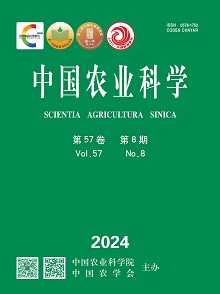【Objective】 In order to provide theoretical foundation for the study of physiological mechanism of nitrogen efficiency in wheat and material basis for the breeding of nitrogen efficiency varieties, the evaluation method for nitrogen efficiency of wheat at mature stage was established to explore and screen nitrogen efficiency germplasm resources. 【Method】 In the field experiment, 108 different genotype wheat varieties were used for the treatment of 4 nitrogen application(0, 180, 240, 360 kg·hm-2). Eleven indexes of major agronomic traits, including plant height, spike length, flag leaf length, flag leaf width, stem diameter, fertile spikelet number, grain number per spike, thousand kernel weight, grain length, grain width and grain weight per spike were measured for two consecutive years. The nitrogen tolerance and genotype difference of wheat varieties were assessed by the method of Fuzzy membership function, principal component analysis and cluster analysis. 【Result】 The results of two-year data show that plant height, spike length, flag leaf length, flag leaf width, stem diameter, fertile spikelet number, spike grain number and grain weight per spike under low nitrogen stress were all inhibited to varying degrees, among which flag leaf length was the most sensitive to nitrogen stress. Four principal components were extracted by principal component analysis, and the contribution rate was 39.766%, 16.661%, 9.361% and 9.275%, respectively. The cumulative contribution rate reached 75.064%. According to the comprehensive evaluation D value of low nitrogen tolerance, the tested wheat varieties were divided into 5 types: strong low nitrogen tolerance, low nitrogen tolerance, intermediate, low nitrogen light sensitive and low nitrogen sensitive. Five low-nitrogen tolerant wheats including Wenmai19, Xinong 529, Shi 4185, Longmai 212 and Fengkang 2 and two strong low-nitrogen tolerant wheats (Zhongmai 875 and Xinong 158) were selected. Different from low nitrogen stress, high nitrogen stress only inhibited 5 traits including stem diameter, thousand kernel weight, grain length, grain width and grain weight per spike, and 6 traits including plant height, spike length, flag leaf length, flag leaf width, fertile spikelet number and spike grain number increased with the increase of nitrogen application. Principal component analysis extracts 4 principal components, the contribution rates are 31.348%, 20.387%, 12.452% and 9.850%, respectively, and the cumulative contribution rate is 74.037%. Based on the D value of comprehensive evaluation of high nitrogen tolerance, the tested wheat varieties were divided into four categories: high nitrogen tolerance type, intermediate type, high nitrogen light sensitive type and high nitrogen sensitive type. Nine wheat varieties with high nitrogen tolerance were identified, including Lankao Aizao 8, Liangxing 99, Nongda 179, Yunnong 9901, Lankao 926 and Zhengnong 46. Based on the D value of comprehensive evaluation of nitrogen and grain yield, 108 wheat varieties were divided into four nitrogen efficiency types, dual-efficiency type (Xinong 158 and Longmai 212 et al.), low-nitrogen efficiency type (Xinong 585 and Shi 4185 et al.), high-nitrogen efficiency type (Changfeng 1 and Zhongsimai 10 et al.) and dual-inefficiency type (Jinfeng 7183 and Fanmai 5 et al.). 【Conclusion】 Nitrogen supply level has a significant influence on wheat yield-related traits and indexes. The nitrogen efficiency of wheat germplasm resources at maturity might be accurately evaluated combined with three evaluation methods, based on the difference of nitrogen absorption and utilization efficiency between wheat germplasm.











